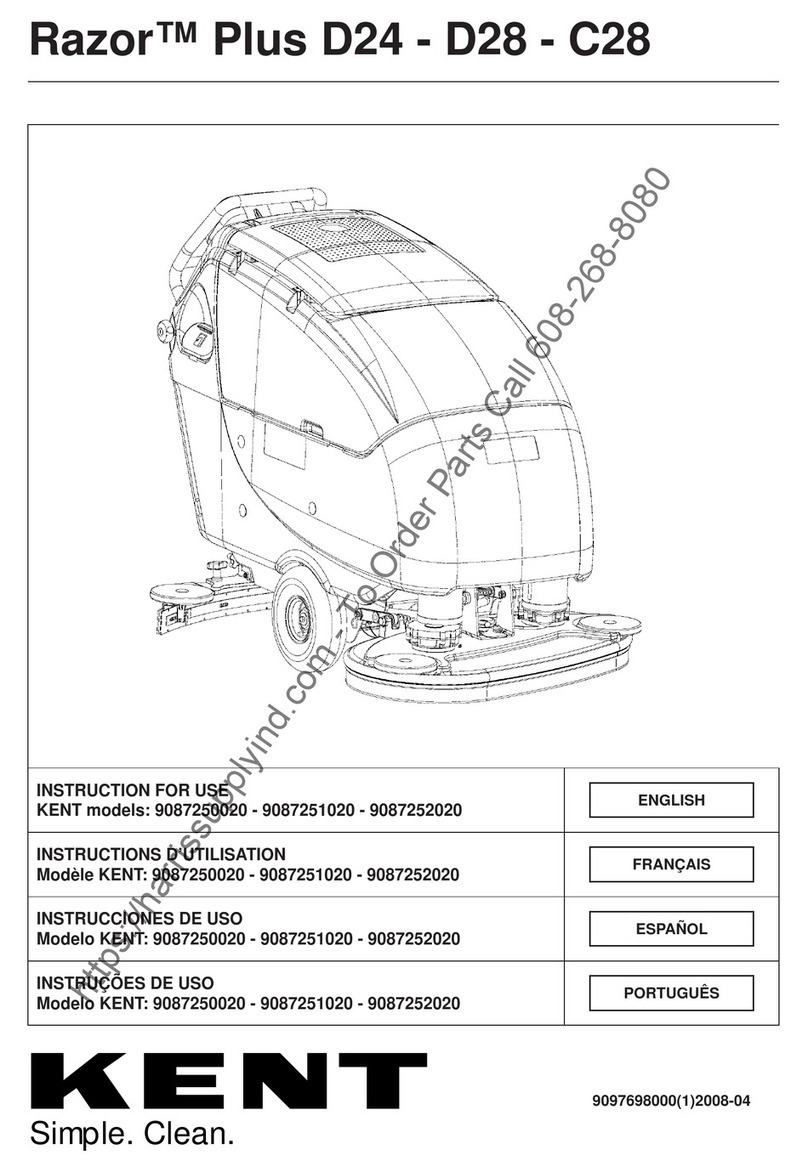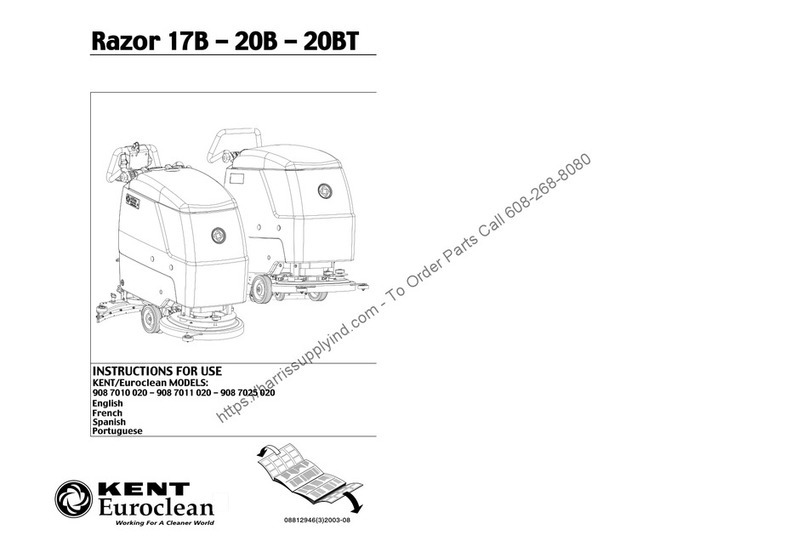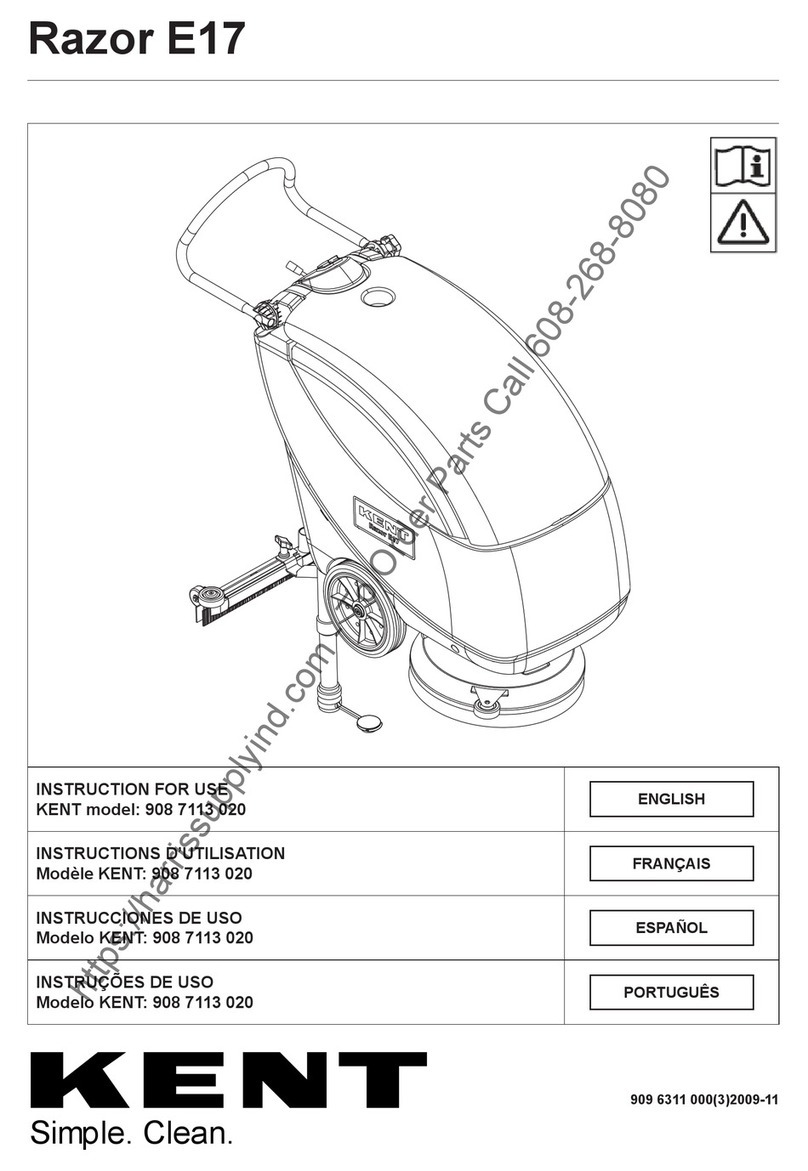INSTRUCTIONS FOR USE
6Blue 32 – 146 2301 000(1)2005-03
3. Fill up each battery cell with sulfuric acid for batteries
(density from 1.27 to 1.29 Kg at 25°C) in accordance
with the instructions specified in the Battery Use and
Maintenance Manual.
The correct quantity of sulfuric acid is indicated in the
Battery Use and Maintenance Manual.
4. Let the battery rest and fill with sulfuric acid in
accordance with the instructions specified in the
Battery Use and Maintenance Manual.
5. Proceed with charging the batteries (refer to the
procedure in the Maintenance chapter).
c. Battery not supplied
1. Buy an appropriate battery (See Technical
Characteristics paragraph and the diagram 10, Fig.
U).
Consult qualified battery retailers to choose and
install the battery.
2. Proceed with machine and battery charger setting
according to the chosen battery type (lead-acid or
gel).
3. Proceed with charging the batteries.
BATTERY INSTALLATION AND BATTERY
TYPE SETTING (WET OR GEL)
According to the battery type (lead – acid or gel) chosen,
perform the setting of the electronic board of the machine
and the battery charger following the instructions as
indicated below:
Machine setting (electronic board)
1. Turn the ignition key (2, Fig. B) to “0” position.
2. Open the hood (7, Fig. C).
3. The machine setting performed at the factory is for
lead – acid (WET) batteries. If the setting
corresponds to the chosen battery, go to the following
paragraph, otherwise perform the following
operations:
4. Disconnect the battery connector (3, Fig. U).
5. Remove the screws (9, Fig. B) and remove the
control panel (1, Fig. B) with care.
6. Install the jumper wire (1, Fig. T) on the “WET”
connectors (2, Fig. T) for lead batteries or on the
“GEL” connectors (3, Fig. T) for gel batteries.
7. Reinstall the control panel and tighten the screws (9,
Fig. B).
8. Reconnect the battery connector (3, Fig. U).
9. Close the hood (7, Fig. C).
Battery charger setting
1. Turn the key (2, Fig. B) to the “0” position; open the
hood (7, Fig. C) and switch the selector (9, Fig. U) to
(WET) for lead – acid batteries or to (GEL) for gel
batteries.
2. Install the battery on the machine according to the
diagram (10, Fig. U).
3. Proceed with charging the batteries (see the
procedure in the Maintenance chapter).
BEFORE START-UP
STARTING AND STOPPING THE MACHINE
At every start-up
1. Insert the ignition key (2, Fig. B) in the control panel;
turn it to the “I” position [without pulling the lever (4,
Fig. C)], then check that the green warning light (5,
Fig. B) turns on.
2. If the warning light becomes yellow or red (3 or 4,
Fig. B) turn the ignition key to “0” position and
remove it. Proceed with recharging the batteries (see
the procedure in the Maintenance chapter).
Starting the machine
1. Adjust the handlebar (3, Fig. C) by means of the
knobs (5), to reach a comfortable position.
2. Lower the side broom (10, Fig. C), disengage the
handle (12) from its latch (2) and lower the knob
(without turning it).
3. Turn the ignition key (2, Fig. B) to the “I” position
without pulling the drive lever (4, Fig. C).
4. Check that the green warning light (5, Fig. B)
(charged battery) turns on. If the warning light
becomes yellow or red (3 or 4, Fig. B), turn the
ignition key to the “0” position and then proceed with
recharging the battery. (See related chapter).
5. Pull the drive lever (4, Fig. C) with care until the
machine starts to move.
The speed is proportional to the pressure applied to
the drive lever (4, Fig. C).
WARNING!
Please pay strict attention when working
with sulfuric acid, as it is corrosive. If it
comes in contact with the skin or the eyes,
wash thoroughly with water and consult a
physician.
Battery has to be filled in a properly
ventilated area. Use protective gloves
NOTE:
Battery charger must be connected to the
batteries for machine to function.
WARNING!
Ensure that the hopper (17, Fig. C) is
correctly closed before starting up the
machine.
NOTE:
the side broom (10, Fig. C) can be lowered
also when it is running.































